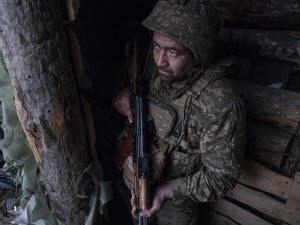A US-led effort to end the war in Ukraine looks favorable to Russia, but
mixed signals emerge
[May 02, 2025]
By DASHA LITVINOVA
TALLINN, Estonia (AP) — The discussions have taken place in an ornate
Kremlin hall, on the polished marble of St. Peter’s Basilica and in a
famously contentious session in the Oval Office of the White House.
What’s emerged so far from the Washington-led effort to end the war in
Ukraine suggests a deal that seems likely to be favorable to Russia:
President Donald Trump has sharply rebuked Ukrainian President Volodymyr
Zelenskyy, echoed Kremlin talking points, and indicated Kyiv would have
to surrender territory and forego NATO membership. What’s more, he has
engaged in a rapprochement with Moscow that was unthinkable months ago.
More recently, Trump has offered mixed signals — social media posts that
perhaps Russian President Vladimir Putin is stringing him along — and a
deal has yet to materialize.
While the optics so far have been in the Kremlin’s favor, no proposals
that were put forth have been cemented.
And on Wednesday, Washington and Kyiv signed an agreement granting
American access to Ukraine’s vast mineral resources that could enable
continued military aid to the country under ongoing attacks from Russia.
Zelenskyy said Thursday the deal was the first result of his “truly
historic” meeting with Trump at the Vatican before the funeral of Pope
Francis.
Dialogue and aligned vision
One gain for the Kremlin is that Washington is talking again to Moscow
after years of extremely strained ties following its 2022 invasion of
Ukraine — and not just about the war, said Nikolay Petrov, senior
research fellow with the New Eurasian Strategies Centre think tank.

Russian officials and state media from the very start of discussions
with Trump’s officials sought to underscore that Ukraine was only one
item on the vast agenda of the “two superpowers.” Trump and Putin talked
in March about Ukraine but also the Middle East, stopping the
proliferation of strategic weapons and even organizing hockey games
between the countries.
Russia's main state TV channel reported that the meeting between Putin
and Trump envoy Steve-Witkoff showed that Moscow and Washington were
building “a new structure of the world” together.
In this sense, “Putin already got a part of what he sought” — the optics
of Russia as a country that is on par with the U.S., Petrov said.
Trump has said Crimea, the Ukrainian peninsula Moscow illegally annexed
in 2014, “will stay with Russia,” and outlines of a peace proposal his
team reportedly presented to Kyiv last month apparently included
allowing Russia to keep control of other occupied Ukrainian territories.
Trump, who had a contentious meeting with Zelenskyy in the Oval Office
on Feb. 28, lashed out at him for publicly rejecting the idea of ceding
land, and also said that Kyiv was unlikely to ever join NATO.
All of these have long been Moscow’s talking points, and Trump’s use of
them suggested his administration’s vision was aligned with the
Kremlin’s.
Trump also seemingly puts more pressure on Kyiv than Moscow in trying to
reach a peace deal and appears eager to return to a more normal
relationship with Russia and its “big business opportunities," said Sam
Greene of King’s College London.
“Is there any part of this that doesn’t look like a win for Russia? No,”
Greene adds.
So far, it's only talk
But so far, all of this has remained nothing but rhetoric, with terms of
a possible settlement still very much “in the air,” says Sergey
Radchenko, a historian and a professor at the Johns Hopkins School of
Advanced International Studies.

Moreover, there are still demands by both Russia and Ukraine that would
be hard to reconcile in any kind of peace settlement.
Ukraine refuses to cede any land and wants robust security guarantees
against future aggression, possibly involving a contingent of
peacekeepers -– something a handful of European nations have been
discussing and Russia publicly rejects as a nonstarter.
[to top of second column]
|

In this photo provided by Ukraine's 93rd Kholodnyi Yar Separate
Mechanized Brigade press service, a soldier looks out of a shelter
on the anti-drone firing position in Kostyantynivka, the site of the
heavy battles with the Russian troops in the Donetsk region,
Ukraine, April 24, 2025. (Iryna Rybakova/Ukraine's 93rd Mechanized
Brigade via AP, File)

Russia, in turn, demands that it holds onto the territory it has
seized as well as no NATO membership for Ukraine. It also wants Kyiv
to “demilitarize,” or significantly reduce its armed force.
Radchenko sees the latter as a major sticking point in peace talks,
because a strong, viable army is important for Ukraine to defend
itself.
“If there are restrictions on the kinds of weapons Ukraine can
receive (from the West) or the size of the army, then it will be
very difficult to get them to accept this sort of agreement,” he
said.
Russian Foreign Minister Sergey Lavrov seemingly raised the stakes
further this week by saying that international recognition of
regions annexed from Ukraine by Russia was “imperative” for a peace
deal.
Achieving that remains unclear, given that dozens of countries have
decried the annexations as violating international law.
What if the US walks away?
Some analysts believe it is in Putin's interest to prolong the war
and keep making gains on the battlefield.
Trump, Vice President JD Vance and Secretary of State Marco Rubio
have threatened to wash their hands of the peace effort if there is
no progress soon.
Putin, in an apparent gesture of willingness to keep talking,
announced this week a 72-hour ceasefire starting May 8 for Russia's
Victory Day holiday that marks the defeat of Nazi Germany in World
War II.
Zelenskyy dismissed the gesture as a further attempt by Putin at
“manipulation” to string along the U.S., saying a ceasefire should
begin immediately and last longer.
Greene noted that the Russian ruble and markets have been doing
better recently over expectations of a peace deal and U.S.
businesses and investors coming back, "and there may be a price to
be paid” for pulling out the rug from under that.

The larger question is what happens on the battlefield if the Trump
administration withdraws from the peace effort.
“When the Trump administration says they’ll walk away, we don’t know
what that means. Does that mean they walk away from negotiations and
keep supporting Ukraine?” Greene said.
Greene says that Ukraine probably doesn’t feel confident that the
U.S. stepping back from the process means that Washington will keep
supporting Kyiv, adding that Russia may not be sure of the Trump
administration ending aid, either.
“I think it’s very difficult for the Kremlin to calculate the risks
of dragging this out,” he said.
And U.S. Treasury Secretary Sctott Bessent said the mineral deal
"signals clearly to Russia that the Trump administration is
committed to a peace process centered on a free, sovereign, and
prosperous Ukraine over the long term.”
A lot depends on whether Europe can step up and fill any gaps in
U.S. aid.
If Trump walks away from the peace effort and still pursues
normalizing relations with Russia, lifting sanctions, “this will
amount to a major breakthrough” for Putin, but it's not a given,
Radchenko says.
That would be an uphill battle for Trump as “there’s a lot of
congressional sanctions that are predicated on the war in Ukraine,”
Greene notes.
All contents © copyright 2025 Associated Press. All rights reserved |